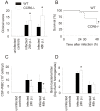Leukocyte attraction by CCL20 and its receptor CCR6 in humans and mice with pneumococcal meningitis
- PMID: 24699535
- PMCID: PMC3974727
- DOI: 10.1371/journal.pone.0093057
Leukocyte attraction by CCL20 and its receptor CCR6 in humans and mice with pneumococcal meningitis
Abstract
We previously identified CCL20 as an early chemokine in the cerebrospinal fluid (CSF) of patients with pneumococcal meningitis but its functional relevance was unknown. Here we studied the role of CCL20 and its receptor CCR6 in pneumococcal meningitis. In a prospective nationwide study, CCL20 levels were significantly elevated in the CSF of patients with pneumococcal meningitis and correlated with CSF leukocyte counts. CCR6-deficient mice with pneumococcal meningitis and WT mice with pneumococcal meningitis treated with anti-CCL20 antibodies both had reduced CSF white blood cell counts. The reduction in CSF pleocytosis was also accompanied by an increase in brain bacterial titers. Additional in vitro experiments showed direct chemoattractant activity of CCL20 for granulocytes. In summary, our results identify the CCL20-CCR6 axis as an essential component of the innate immune defense against pneumococcal meningitis, controlling granulocyte recruitment.
Conflict of interest statement
Figures







References
-
- van de Beek D, de Gans J, Tunkel AR, Wijdicks EF (2006) Community-acquired bacterial meningitis in adults. N Engl J Med 354: 44–53. - PubMed
-
- Klein M, Pfister HW, Leib SL, Koedel U (2009) Therapy of community-acquired acute bacterial meningitis: the clock is running. Expert Opin Pharmacother 10: 2609–2623. - PubMed
-
- Koedel U, Angele B, Rupprecht T, Wagner H, Roggenkamp A, et al. (2003) Toll-like receptor 2 participates in mediation of immune response in experimental pneumococcal meningitis. J Immunol 170: 438–444. - PubMed
-
- Klein M, Obermaier B, Angele B, Pfister HW, Wagner H, et al. (2008) Innate immunity to pneumococcal infection of the central nervous system depends on toll-like receptor (TLR) 2 and TLR4. J Infect Dis 198: 1028–1036. - PubMed
-
- Klein M, Paul R, Angele B, Popp B, Pfister HW, et al. (2006) Protein expression pattern in experimental pneumococcal meningitis. Microbes and Infection 8: 974–983. - PubMed
Publication types
MeSH terms
Substances
LinkOut - more resources
Full Text Sources
Other Literature Sources
Molecular Biology Databases

